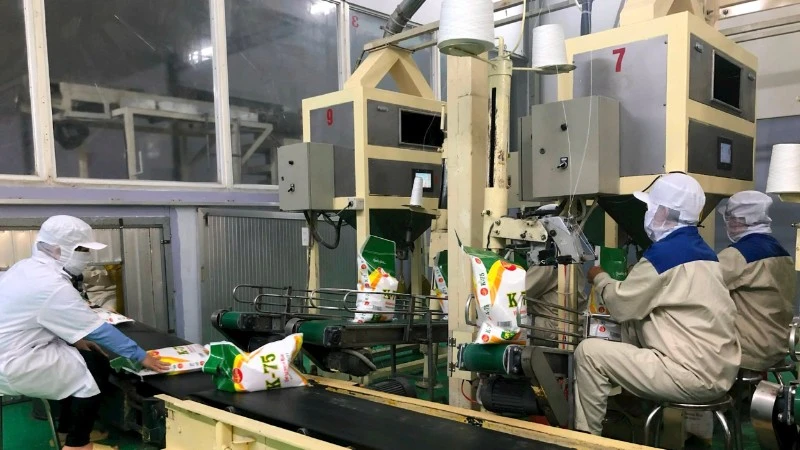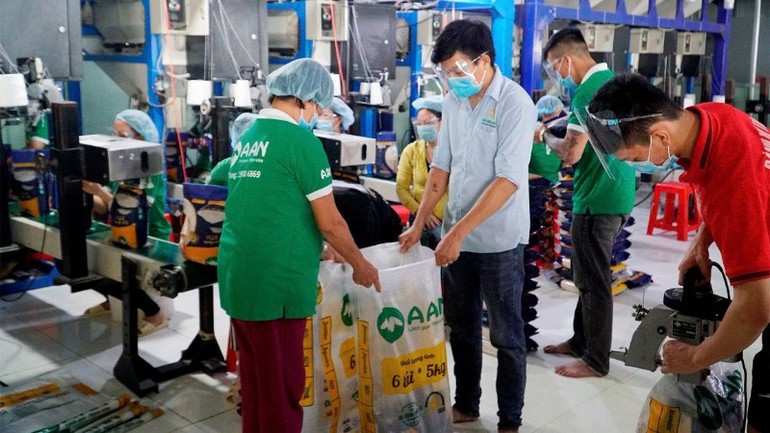Expectations for rice exports to new markets
In the first seven months of 2025, Viet Nam’s total rice export volume reached 5.5 million tonnes, up 3.1% compared to the same period in 2024, but the export value was only 2.81 billion USD, down 15.9%. To achieve the target of 5.7 billion USD for the whole of 2025, the rice sector needs to make efforts to expand export markets, focusing on new potentially high-value markets.

The average export price of Viet Nam’s rice in the first seven months of 2025 was only 514 USD/tonne, down 18.4% from the same period in 2024. Rice exports fell sharply in traditional markets such as the Philippines, Malaysia, and Indonesia.
Opportunities from new markets
According to the Ministry of Agriculture and Environment, in the first seven months of 2025, among the major export markets, the export value of rice to Bangladesh recorded the highest increase, rising 188.2 times, while Malaysia saw the steepest decline of 58.5%. The traditional market of the Philippines also recorded a 13.5% drop. The reason is that traditional markets are increasing their rice reserves while boosting production for self-sufficiency.
Figures from the Viet Nam Food Association show that as of early June 2025, the total rice reserves in the Philippines reached 2.239 million tonnes, up 3.5% compared to the same period in 2024. In Indonesia, the country has raised its rice production target for 2026 to 33.8 million tonnes, up from the original target of 32 million tonnes.
With export prices falling and traditional markets shrinking, the requirement for exporters is to expand markets and prioritise high-quality, high-value rice exports.
Truong Sy Ba, Chairman of the Board of Directors of Tan Long Group, said the group maintains rice exports to high-priced markets, including Japan. In 2024, Tan Long exported about 5,000 tonnes of A An-branded rice to Japan. In 2025, the volume exported to Japan is expected to reach 30,000 tonnes.
“Exporting rice to Japan requires meeting many stringent criteria, including controlling more than 600 different substances. If any substance exceeds the permitted limit, the entire rice shipment can be returned. However, the export value to this market is very high, with 1,000 tonnes of rice exported to Japan equivalent to the value of tens of thousands of tonnes exported to other markets,” said Ba.

In addition to Japan and the Republic of Korea, European countries are also gradually becoming high-potential markets for high-quality rice. Austria is located in Central Europe, with a population of about 9 million. According to the Viet Nam Trade Office in Austria, although not a traditional rice-consuming nation like Asian countries, in recent years, the demand for rice in Austria has increased rapidly as people have become more health-conscious, adopted vegetarian diets, and embraced diverse culinary styles. Rice has become a preferred choice for dishes such as sushi, fried rice, and many other Asian foods.
In Canada, with about 7 million people of Asian origin, the country also has potential as a rice-consuming market. Viet Nam is currently among the top five rice-exporting countries to Canada. However, according to statistics from the Viet Nam Trade Office in Canada, the country’s annual rice import demand is about 500 million USD, while Viet Nam’s rice exports to this country are only about 12 million USD per year, leaving considerable room for market share expansion.
Improving quality and enhancing trade promotion
Commercial Counsellor at the Viet Nam Trade Office in Austria, Dinh Thi Hoang Yen, said that more and more Austrian consumers are choosing Vietnamese rice for their daily meals. Recent surveys show that Austrians appreciate Vietnamese rice for its long, white, fragrant, and flexible grains, suitable for many traditional and modern dishes. Recently, the Viet Nam Trade Office in Austria connected with 3Brothers company to import Vietnamese sushi rice into the market in 10 kg packaging, which has been well received by customers.
However, the challenge in exporting rice to Austria lies in the strict requirements on quality, traceability, and regulations related to environmental protection and consumer rights. In addition, Vietnamese rice must compete directly with rice from other countries, requiring businesses to invest heavily in processing technology and market research.
Recognising that improving rice quality is the “key” to unlocking new markets, many Vietnamese rice exporters have been making efforts to apply technology, invest in production, processing, and consumption chains to build the Vietnamese rice brand.
According to Huynh Van Thon, Chairman of the Board of Directors at Loc Troi Group Joint Stock Company, the group has been strongly applying technology in production and management; developing the Japo 3 Mua rice variety, which can be cultivated for up to three crops per year with a light fragrance, moderate stickiness, and rich flavour, meeting the stringent standards of premium markets; and launching the Vibigaba germ rice product line, which not only offers health benefits but also has high economic value, with export prices 10 times higher than ordinary white rice. The group has also established a farm management system to ensure each field has its own data profile.
Currently, Loc Troi owns twelve rice varieties licensed for production and business, including ten new varieties researched and recognised for circulation by the company itself. Many of these varieties are exported to Japan and Indonesia at high economic value.
In the context of global rice export prices continuing to trend downward, coupled with fluctuating rice consumption demand in traditional import markets, markets with potential for high-quality exports are expected to bring new revenue sources for Vietnamese rice. This is also a great opportunity for Vietnamese rice to affirm its value through quality and branding in the international market.








